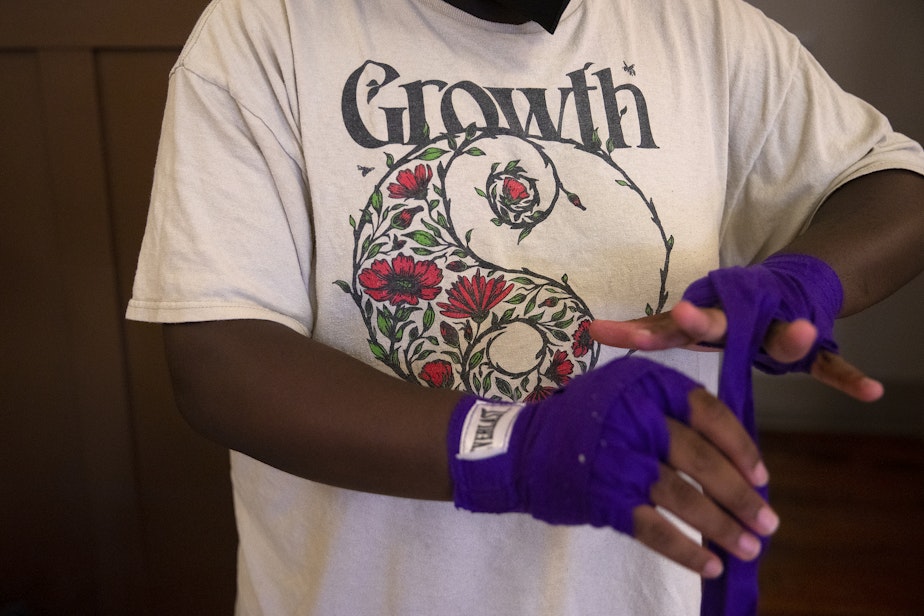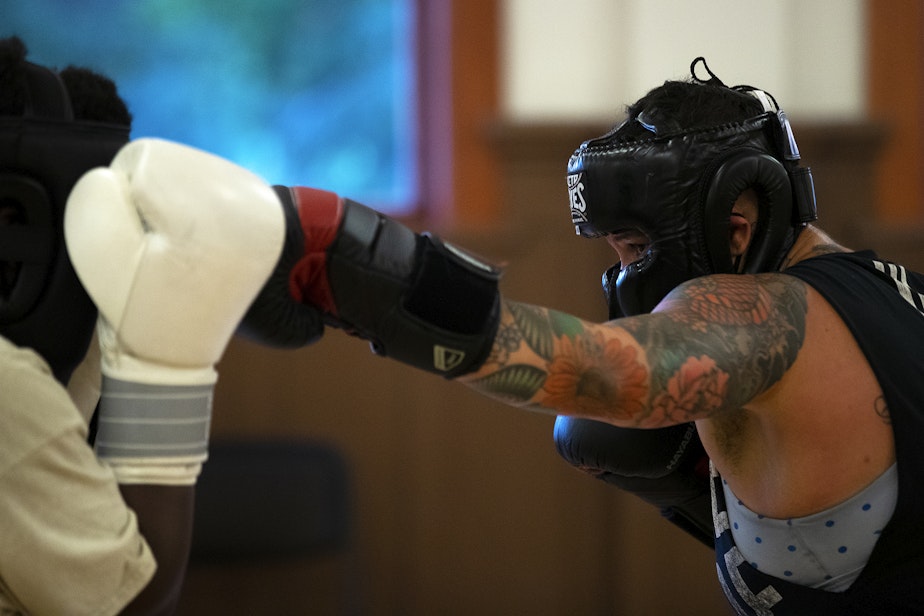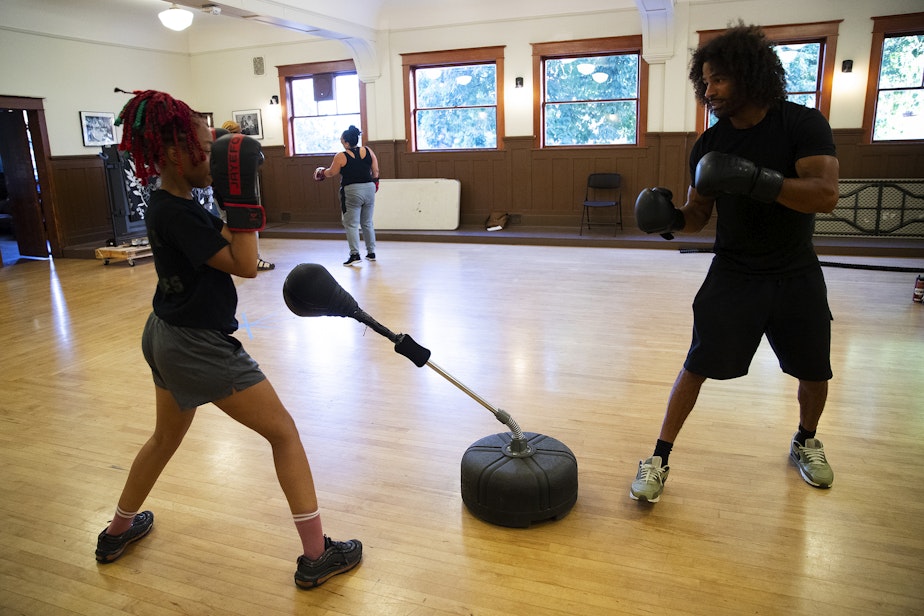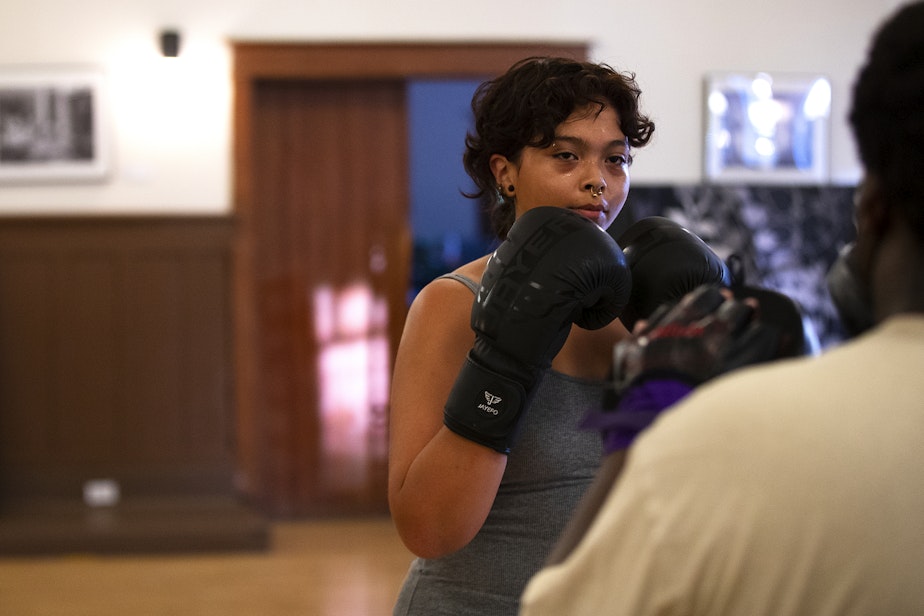IIn the main hall of Washington Hall in the Central District, rows of chairs have been cleared to transform the space into a makeshift boxing training ground. The space now houses two free-standing punching bags, seven people, and a noisy industrial fan to keep the air circulating — it can get hot and sticky in the summer.
Specifically the punching bag that 21-year-old Sky Muse has her eye on.
All day, he didn’t want to talk to anyone. Someone had bothered him on public transportation a few days earlier, and the thing was still near him.
“So I’m going to put it in [punching] bag,” he said after tightening the laces of his boxing gloves. Now 21, he has been boxing since he was 11.
“Just being able to…attack something — where I can’t attack someone or something that’s upsetting me. It gives me some kind of clarity, it gives me some kind of relief because I’m able to get it out emotionally,” Muse added.
Creative Justice’s boxing program introduces young people like Muse to fighting and conflict in a controlled environment, said Darnel Hill, the program’s coach. The organization is part of a network of nonprofit intervention programs aimed at keeping kids out of the criminal justice system and engaging them in extracurricular activities. Many of the programs are free to participants and rely on state and local funding.
RELATED: High school-aged children increasingly face criminal charges in King County

Boxing wasn’t always offered at Creative Justice, which started out as an arts program. Hill was a creative writing teacher for the organization until 2022, when he noticed a series of conflicts occurring among students.
Before things get out of hand, he needs to find a way to defuse tensions, he said. Hill, who also runs physical training workshops for professional athletes, has boxing gloves that he gives his students to work out their differences — without an audience.
“[Now] “They grabbed each other’s gloves, boxed together, and bumped fists,” Hill said. “We talked, three months later, they shook hands. And it was just amazing to see that transition into a real friendship.”
When participants see fights outside the training ground, he hopes they will know to stay away, he added.
“What I tell people — especially my kids — is, ‘You have to respect violence,’” Hill said. “When you’re on the street and you’re a real boxer, or you’re in the gym, you don’t watch fights for long, because you respect violence. You know that other things come out of it,” like shootings.
“There are 1,000,001 ways that we can actually heal the harm and then prevent it in the future,” said Nikkita Oliver, executive director of Creative Justice.
RELATED: Seattle City Council votes against increasing student mental health funding by another $20 million

One such gym, the SeaMar Youth Boxing Club, opened in Seattle’s South Park neighborhood in 2000. That’s when Juan Garcia began training young people to box – at no cost to them – to help them stay out of trouble and graduate from high school.
But the 2005 shooting death of 16-year-old Fernando Esqueda helped catalyze South Park residents to do more. That meant building relationships with police and advocating for more mental and behavioral health programs for teens.
Garcia recalled worrying about retaliation in the community after Esqueda’s death, and increased levels of police violence.
“Rather than reacting with violence… we want those high-risk kids to come to the gym,” Garcia said. “Back in 2005, we had a lot of gang members. The whole gym was full of gang members.”
It also means having clear, firm boundaries about what young people can and can’t do. Garcia said he’s had to remove a star boxer from his roster for bringing a knife to school. But that scenario is the exception — and a reminder that everyone has a responsibility to create a safe environment, he said.

“Success” is the key word, Garcia said. Once young people have the resources to achieve small wins, those wins can be channeled into bigger successes.
“I think it changes the lives of young people because a lot of them feel like they’re not succeeding at anything — at least kids of color and black kids, they’re pushed aside and pushed aside.”
RELATED: Juvenile crime is on the rise in King County. Officials disagree on how to deal with it
And while Garcia and other mentors encourage young people to excel in school, they must keep their home lives in mind.
Now, the first generation of young boxers coached by Garcia are bringing their children into the program. Garcia has retired from his role as head coach, but will stay on through the end of the year to help the program transition into its next chapter.
“I think we made an impact on South Park over the years by knowing that there was an opportunity for [young people] to come to a safe place,” he said.

Creating a sense of participant-determined safety is also a major concern for Oliver, Creative Justice’s executive director.
“I think our biggest challenge, but also what makes this program great, is that we really try to listen and tune in to what young people need and want,” Oliver said.
Garcia and Oliver both said they would like to see the city allocate more funding to programs like theirs.
RELATED: The local government’s controversial attempt to divert juvenile criminal cases to community groups has failed to achieve its goal.
Meanwhile, Sky Muse says training at Washington Hall has many benefits — including intangible ones.
“It’s something that helps with mental and emotional health which we need to talk about today. It also creates intergenerational connections because there are people of different ages and different stories coming here, just to box.”
#Seattle #youth #boxing #clubs #offer #lessons #resolving #conflict